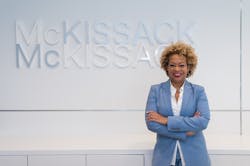Airport development and construction projects—from renovating facilities to adding runways to designing and building new terminals—take flight over years. For the teams that win them, they’re complex, challenging, fulfilling and most significantly, financially rewarding projects. They pay well, tend to be long-term and are the jewel in the crown of companies’ portfolio.
But just as in every field, minority construction firms have a hard time breaking into the elite ranks of prime contractors on airport expansion projects. This isn’t surprising; Blacks are profoundly underrepresented in architecture, engineering and construction, even as concern grows among AEC firms over a shrinking qualified labor pool. Diversity and inclusion programs have had limited success in an industry with continued high demand for skilled labor, even during the coronavirus pandemic.
However, in the last decade, some airport authorities and metropolitan aviation departments have made great strides to change this equation by tailoring procurement programs to expand their pipeline of woman- and minority-owned business enterprises and allow them more growth opportunities. From our perspective as an AEC firm, this has been particularly effective for mid-sized WMBEs such as McKissack & McKissack.
Before airports adopted these diversity and inclusion initiatives, it was nearly impossible for mid-sized WMBEs to work on airport development or construction projects, except as subcontractors in limited roles. Small minority firms could gain a foothold by bidding for Disadvantaged Business Enterprise (DBE) contracts, but mid-sized minority firms have been limited by U.S. Department of Transportation rules that create inequities.
For example, to qualify as a DBE a firm can’t have revenue over $23.98 million and its owners’ net worth can’t exceed $1.32 million. And that’s up from earlier limits of $17 million in revenue and $1.1 million in net worth. Those measures force mid-sized firms with proven capabilities to compete with the “big boys”—incumbent contractors, often public companies, that are exponentially larger and have revenues in the hundreds of millions of dollars.
In my conversations within the AEC industry, I’ve stressed the need to support the midsize woman- and minority-owned firms that often are frozen out as prime contractors on aviation projects. Firms like mine often are victims of their own success—too big to qualify as disadvantaged, too small to compete with billion-dollar rivals.
But some leaders in the current crop of airport administrators understand the role that woman and minority owned business enterprises (WMBEs) play in creating opportunities for local growth. Long before this year’s events have put systemic racism in a new light, they have been developing and running programs to expand opportunities for larger minority contractors. Most notable have been the Metropolitan Washington Airports Authority, which oversees Ronald Regan Washington National Airport and Dulles International Airport, and Chicago Department of Aviation, which oversees O’Hare and Midway International Airports.
Overcoming Award Limits for Minority Contractors in Aviation
Changing the equation has taken work on behalf of these vanguard administrators because airports have been limited in their ability to award contracts to minority businesses by federal laws. Capital awards funded by the Federal Aviation Administration’s Airport Improvement Program must follow federal contracting laws, and the U.S. DOT’s DBE awards are narrowly tailored by design, as mentioned above.
Municipal airports face other constraints on minority hiring. In 1989, the U.S. Supreme Court barred cities from requiring general contractors to set aside subcontracting work for minority-owned firms. In the decade that followed, Ward Connerly of the American Civil Rights Institute pushed for new state actions to limit race and gender contracting preferences, including California's Proposition 209 in 1996, Washington state’s Initiative 200 in 1998 and the One Florida initiative in 1999.
The net result is that only very small firms tend to be certified contractors, without a path to grow beyond a limited subcontracting role. A local MWBE program may cap receipts at $3 million, yet a $3 million company may not have the resources to bid as a prime contractor. Helping minority contractors bridge this gap and become direct suppliers is part of the seven-step plan I’ve proposed for increasing minority representation in the AEC workforce.
Vanguard Diversity & Inclusion Efforts in the Aviation Workplace
Fortunately, procurement leaders and managers of aviation agencies have produced new ways to bring in and develop minority firms.
At Washington’s Dulles and Reagan airports, the nations only federally owned commercial airports, change started at the board level. Warner Session, a mayoral appointee to the Metropolitan Washington Airports Authority, led an initiative to assure minority participation on the MWAA board and in contracts. In the late 1980s MWAA created a department committed to ensuring supply chain diversity. McKissack & McKissack’s long-running relationship with MWAA is an example of an airport authority increasing its commitment to minority and local businesses.
“Diversity has been a multidecade initiative and a focus of our board of directors, to make sure the authority is engaging with the small businesses in our region,” Julia Hodge, the MWAA’s vice president for supply chain management, told me. They have really pushed to create opportunities for local minority and small businesses to be primes. Thanks to their efforts, we are the prime on a $10 million contract for project controls and project management at MWAA.
“We are taking active steps to create opportunities to bring minorities to all of our goods and services,” Hodge said, “from AEC firms and consultants to lawyers, financial advisors and independent auditors.” MWAA has over 1,700 firms in its certification database. Its outreach to minority firms includes programs to build technical skills, submit successful proposals and partner with a larger organization. “We provide feedback early and often so that bidders feel like they are getting a fair shake, and if they aren’t successful on the most recent effort the opportunity will come around again.”
In August, the FAA recognized MWAA for exceeding its minority participation goals three years in a row.
McKissack has worked at O’Hare International Airport for two decades and is working with Austin Power Partners and Turner FH Paschen JV, two of three construction managers at risk in the massive terminal expansion. But Jamie Rhee, commissioner of the Chicago Department of Aviation put a Target Market program in when she was appointed took over the agency in 2018.
She developed the program to give exclusive opportunities for women- and minority-owned enterprises to be lead contractors.
Target Market contracts go beyond custodial, security and property management services to include architecture, engineering and construction management. In fact, my inspiration for this piece was a Target Market RFP the CDA has out right now for construction manager-as-agent services. It’s a significant opportunity for a minority firm to work on major facilities at O’Hare.
“Being a prime can put them in the driver's seat to make decisions, instead of always being looked at as a subcontractor,” said. “If you put out a $70 million bid for construction, I can count on my hand who could bid on that and it's not minority and women-owned. So we have put programs in place to start unbundling these and build capacity.”
Deborah Flint, CEO of the Greater Toronto Airports Authority, undertook a similar initiative when she was CEO at the Los Angeles World Airports (LAWA) from 2015 to 2019, creating midsized contracts that minority firms could pursue at Los Angeles International Airport.
Rhee sees O’Hare International Airport’s $8.5 billion terminal expansion plan as an opportunity to bring in more certified minority contractors. When Chicago renegotiated its airport use and lease agreement in 2018, Rhee pushed for capital spending flexibility as chief procurement officer, limiting the "majority in interest” (MII) veto power of hub airlines. Its Terminal Area Plan sets local participation by minority, women, disabled, veteran, returning citizens and LGBTQIA businesses.
O’Hare brings Chicago more than $8 billion a year in operating revenues–landing fees and terminal charges not subject to federal Disadvantaged Business Enterprise rules. The new lease agreement gave Rhee immediate options as aviation commissioner to consider minority- and women-owned service businesses using city bid incentives, which were opened up to South and West Side firms located where income and employment are lagging. In taking the aviation helm that year, Rhee restructured contracts to be smaller in size and scope.
“The minute I walked in the door I said, ‘I want to see everybody's contracts,’” Rhee said. “You are going to see diversity on every spectrum, every size of firm.” With many five-year professional services contracts expiring, Rhee gave small and midsize firms prime-level opportunities. Chicago airports now have qualified talent pools for construction manager-as-agent and quality-assurance or compliance work.
As an established minority contractor, McKissack has been encouraging creative strategies to attract diverse workers, from internships and mentorship programs to recruiting at historically Black colleges and universities. Competition will drive lower costs for airlines and passengers.
But beyond saving money, the aviation industry needs to renew its workforce for a more diverse future. Boeing’s pilot and technician outlook predicts a rising need for manpower--212,000 new pilots in North America alone, plus 193,000 technicians, 176,000 cabin crew members and all the services needed by a multibillion-dollar industry. The inequities uncovered by the coronavirus pandemic and the Black Lives Matter movement make this the time to put in place programs that commit not only to using minority suppliers, but changing the face of the aviation industry for the next generation.








